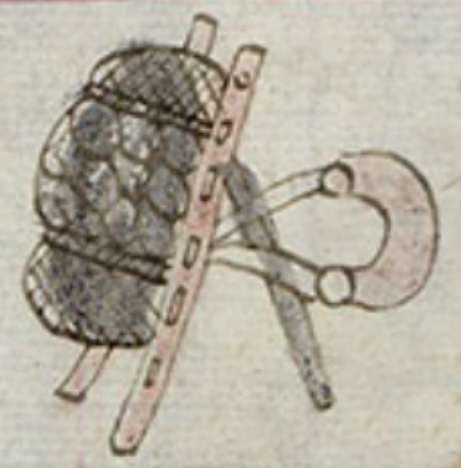centlamamalli (CST31)
This painting of the simplex glyph for the term centlamamalli (a load) shows a carrying frame standing on the ground. It has a load of cacao beans on it, and it has a tumpline with a forehead brace. The beans are visible inside the bundle, which has a partial mesh pattern. The pink frame is like a ladder, but there is an extra leg (here, gray) coming out the back that helps it stand on its own. The companion text explains that these cacao beans are for the rulers (tlatoque) at the palace and the church people (teopannenque). They “drink it” (the chocolate that is made from the cacao).
Stephanie Wood
For more on the Codex Sierra, see Kevin Terraciano’s study (2021), especially pages 119 and 154, which have the transcription and translation of the companion text. This carrying frame looks something like a cacaxtli.
Stephanie Wood
1550–1564
Jeff Haskett-Wood
tamemes, tlamama, cargar, cargas, cacao, tomar, chocolate, mecapalli, mecapal, mecapales, ixcuamama, tecnologia, madera

centlamamal(li), a load, https://nahuatl.wired-humanities.org/content/centlamamalli
aparato de transporte, o una carga
Stephanie Wood
Códice Sierra-Texupan, plate 31, page dated 1560. Origin: Santa Catalina Texupan, Mixteca Alta, State of Oaxaca. Kevin Terraciano has published an outstanding study of this manuscript (Codex Sierra, 2021), and in his book he refers to alphabetic and “pictorial” writing, not hieroglyphic writing. We are still counting some of the imagery from this source as hieroglyphic writing, but we are also including examples of “iconography” where the images verge on European style illustrations or scenes showing activities. We have this iconography category so that such images can be fruitfully compared with hieroglyphs. Hieroglyphic writing was evolving as a result of the influence of European illustrations, and even alphabetic writing impacted it.
https://bidilaf.buap.mx/objeto.xql?id=48281&busqueda=Texupan&action=search
The Biblioteca Digital Lafragua of the Biblioteca Histórica José María Lafragua in Puebla, Mexico, publishes this Códice Sierra-Texupan, 1550–1564 (62pp., 30.7 x 21.8 cm.), referring to it as being in the “Public Domain.” This image is published here under a Creative Commons license, asking that you cite the Biblioteca Digital Lafragua and this Visual Lexicon of Aztec Hieroglyphs.



